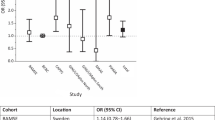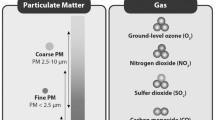Abstract
Over the past several decades, there has been increased awareness of the health effects of air pollution and much debate regarding the role of global warming. The prevalence of asthma and allergic disease has risen in industrialized countries, and most epidemiologic studies focus on possible causalities between air pollution and these conditions. This review examines salient articles and summarizes findings important to the interaction between allergies and air pollution, specifically volatile organic compounds, global warming, particulate pollutants, atopic risk, indoor air pollution, and prenatal exposure. Further work is necessary to determine whether patients predisposed to developing allergic disease may be more susceptible to the health effects of air pollutants due to the direct interaction between IgE-mediated disease and air pollutants. Until we have more definitive answers, patient education about the importance of good indoor air quality in the home and workplace is essential. Health care providers and the general community should also support public policy designed to improve outdoor air quality by developing programs that provide incentives for industry to comply with controlling pollution emissions.
Similar content being viewed by others
References and Recommended Reading
Bernstein JA, Alexis N, Barnes C, et al.: Health effects of air pollution. J Allergy Clin Immunol 2004, 114:1116–1123.
Bernstein JA, Alexis N, Bacchus H, et al.: The health effects of nonindustrial indoor air pollution. J Allergy Clin Immunol 2008, 121:585–591.
Nielson GD, Larsen ST, Olsen O, et al.: Do indoor chemicals promote development of airway allergy? Indoor Air 2007, 17:236–255.
Kim JL, Elfman L, Mi Y, et al.: Indoor molds, bacteria, microbial volatile organic compounds and plasticizers in schools—associations with asthma and respiratory symptoms in pupils. Indoor Air 2007, 17:153–163.
Beggs PJ: Impacts of climate change on aeroallergens: past and future. Clin Exp Allergy 2004, 34:1507–1513.
Bartra J, Mullol J, del Cuvillo A, et al.: Air pollution and allergens. J Investig Allergol Clin Immunol 2007, 17(Suppl 2):3–8.
Behrendt H, Kasche A, Ebner von Eschenbach C, et al.: Secretion of proinflammatory eicosanoid-like substances precedes allergen release from pollen grains in the initiation of allergic sensitization. Int Arch Allergy Immunol 2001, 124:121–125.
Mosges R, Klimek L: Today’s allergic rhinitis patients are different: new factors that may play a role. Allergy 2007, 62:969–975.
Riedl M, Diaz-Sanchez D: Biology of diesel exhaust effects on respiratory function. Am Acad Allergy Asthma Immunol 2005, 115:221–228.
Davila I, Mullol J, Bartra J, et al.: Effect of pollutants upon patients with respiratory allergies. J Investig Allergol Clin Immunol 2007, 17(Suppl 2):9–20.
D’Amato G, Cecchi L: Effects of climate change on environmental factors in respiratory allergic diseases. Clin Exp Allergy 2008, 38:1264–1274.
Salvi SS, Nordenhall C, Blomberg A, et al.: Acute exposure to diesel exhaust increases IL-8 and GRO-alpha production in healthy human airways. Am J Respir Crit Care Med 2000, 161:550–557.
Finkelman FD, Yang M, Orekhova T, et al.: Diesel exhaust particles suppress in vivo IFN-gamma production by inhibiting cytokine effects on NK and NKT cells. J Immunol 2004, 172:3808–3813.
Mudway I, Senfors N, Duggan S, et al.: An in vitro and in vivo investigation of the effects of diesel exhaust on human airway lining fluid antioxidants. Arch Biochem Biophys 2004, 423:200–212.
Bastain T, Gilliland F, Li Y, et al.: Intraindividual reproducibility of nasal allergic responses to diesel exhaust particles indicates a susceptible phenotype. Clin Immunol 2003, 109:130–136.
Li N, Xia T, Nel AE: The role of oxidative stress in ambient particulate matter-induced lung diseases and its implications in the toxicity of engineered nanoparticles. Free Radic Biol Med 2008, 44:1689–1699.
Li N, Sioutas C, Cho A, et al.: Ultrafine particulate pollutants induce oxidative stress and mitochondrial damage. Environ Health Perspect 2003, 111:455–460.
Charpin D, Pascal L, Birnbaum J, et al.: Gaseous air pollution and atopy. Clin Exp Allergy 1999, 29:1474–1480.
Nicolai T, Carr D, Weiland SK, et al.: Urban traffic and pollutant exposure related to respiratory outcomes and atopy in a large sample of children. Eur Respir J 2003, 21:956–963.
Morgenstern V, Zutavern A, Cyrys J, et al.: Atopic diseases, allergic sensitization, and exposure to traffic-related air pollution in children. Am J Respir Crit Care Med 2008, 177:1331–1337.
Oftedal B, Brunekreef B, Nystad W, Nafstad P: Residential outdoor air pollution and allergen sensitization in schoolchildren in Oslo, Norway. Clin Exp Allergy 2007, 37:1632–1640.
Torres-Duque C, Maldonado D, Perez-Padilla R, et al.: Biomass fuels and respiratory diseases: a review of the evidence. Proc Am Thor Soc 2008, 5:577–590.
Bruce N, Perez-Padilla R, Albalak R: Indoor air pollution in developing countries: a major environmental and public health challenge. Bull World Health Organ 2000, 78:1078–1092.
Venn AJ, Yemaneberhan H, Bekele Z, et al.: Increased risk of allergy associated with the use of kerosene fuel in the home. Am J Respir Crit Care Med 2001, 164:1660–1664.
Wong T, Yu T, Liu H, Wong A: Household gas cooking: a risk factor for respiratory illnesses in preschool children. Arch Dis Child 2004, 89:631–636.
Algar OG, Pichini S, Basagana X, et al.: Concentrations and determinants of NO2 in homes of Ashford, UK and Barcelona and Menorca, Spain. Indoor Air 2004, 14:298–304.
Sherriff A, Farrow A, Golding J, Henderson J: Frequent use of chemical household products is associated with persistent wheezing in pre-school age children. Thorax 2005, 60:45–59.
Hertz-Picciotto I, Park H-Y, Dostal M, et al.: Prenatal exposures to persistent and non-persistent organic compounds and effects on immune system development. Basic Clin Pharmacol Toxicol 2008, 102:146–154.
Grevenynghe JV, Rion S, Ferrec EL, et al.: Polycyclic aromatic hydrocarbons inhibit differentiation of human monocytes into macrophages. J Immunol 2003, 170:2374–2381.
Laupeze B, Amiot L, Sparfel L, et al.: Polycyclic aromatic hydrocarbons affect functional differentiation and maturation of human monocyte-derived dendritic cells. J Immunol 2002, 168:2652–2658.
Jedrychowski W, Galas A, Pac A, et al.: Prenatal ambient air exposure to polycyclic aromatic hydrocarbons and the occurrence of respiratory symptoms over the first year of life. Eur J Epidemiol 2005, 20:775–782.
Author information
Authors and Affiliations
Corresponding author
Rights and permissions
About this article
Cite this article
Kim, H., Bernstein, J.A. Air pollution and allergic disease. Curr Allergy Asthma Rep 9, 128–133 (2009). https://doi.org/10.1007/s11882-009-0019-0
Published:
Issue Date:
DOI: https://doi.org/10.1007/s11882-009-0019-0




